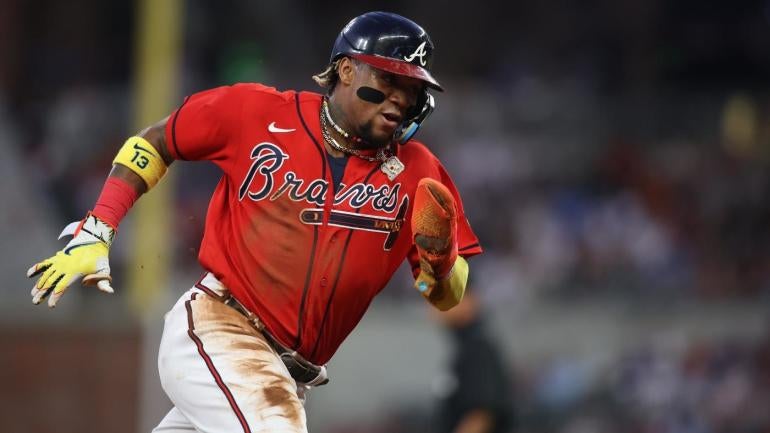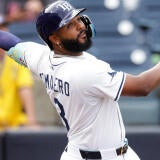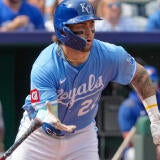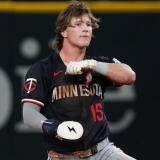2024 Fantasy Baseball Draft Prep: Worst-case scenarios for Ronald Acuna, Corbin Carroll, other first-rounders
Spring is the time for eternal optimism but Chris Towers breaks down all the things that could go wrong

Nobody wants to think about how things can go wrong when picking their Fantasy Baseball team. Spring is, after all, the time of eternal optimism in baseball, and even though you know someone is going to finish in last place in your league, you never think it's going to be you when you leave your draft.
But, here's the thing: Things are going to go wrong. Yes, maybe even for your first-round pick! It's less likely for your first-round pick to go wrong than basically any other pick, but it happens literally every season to at least a few picks in the first round.
If you're lucky, you're looking at relatively small misses, like with Vladimir Guerrero or Trea Turner last year; they didn't live up to expectations, but both were still top-50 players in Fantasy. If you're unlucky, you might spend a first-round pick on the equivalent of a 2022 Bryce Harper, who played just 99 games and had his worst OPS since 2016.
Now, the thing about that is, even that down Harper season still saw him post a .286/.364/.514 line with 18 homers and 11 steals; in 2021, Jacob deGrom threw just 92 innings, but with a 1.08 ERA and 0.554 WHIP as a first-rounder. These guys are going where they are for a reason, and the bottom rarely truly falls out for first-round picks.
But it can still hurt when things go wrong with your first pick, and this column is all about trying to identify how things could go wrong for each of the players with an ADP inside of the first 12 picks in NFBC drafts as of early-February. Here's what it could look like (and we are, for the most part, ignoring scenarios like, "He got hurt," because that could happen to anyone):
Ronald Acuña, OF, Braves – ADP: 1.0
If you're in a standard snake draft, it's hard to see how things could go wrong for Acuña, who combines elite plate discipline (11.4% K rate, 10.9% walk rate) with some of the best quality of contact in the league – his .493 expected wOBA on contact last season was behind only Shohei Ohtani. Oh, and he's an elite athlete who stole 73 bases last season. If you discount him 20% in every category from last season, you'd still be looking at 119 runs, 33 homers, 85 RBI, 58 steals, and a .270 average, which would be perfectly fine for the No. 1 overall pick.
So, if, as stipulated, we're ignoring injury risk (Acuña did tear his ACL three years ago, for what it's worth), then the only thing I can say is, if you play in an Auction/Salary Cap league, the bids for Acuña are going to be truly outrageous. I have him valued as a $55 player in Roto/category leagues, and there's almost no chance I'll ever actually be able to get him for $55 of a $260 budget. Using the FanGraphs Auction Calculator tool, Acuña was a $68 player last season, and I would be surprised if he goes for less than $60 in most drafts. At that price, Acuña can't just be one of the best players in Fantasy – he needs to lap the field. Acuña is a good bet to be the No. 1 player – the surest thing we've had at least since Mike Trout's peak – but generally speaking, you're better off betting against any given player finishing No. 1 vs. the field. If Acuña comes anywhere close to repeating last season's production, it won't matter, but any regression could make for a razor-thin margin for error at his likely auction price.
Bobby Witt, SS, Royals – ADP: 2.89
I think the biggest case against Witt comes down to just normal regression to the mean. I don't mean that in the, "he overperformed!" sense, because Witt probably has a bit of room for growth based on the skill set he showed last night – his .343 wOBA trailed his expected wOBA of .369 by a pretty significant margin. No, the regression I'm talking about here would be back toward his 2022 skill set, where his quality of contact was good, but not great, and he struck out more than 20% of the time. I don't expect that to happen, necessarily, given Witt's age and the big leap he made last season. But he plays in a tough home park and a mediocre lineup, and progress isn't always linear, so a step back wouldn't be unheard of – Julio Rodriguez had a similar bit of regression last year, for example.
Julio Rodriguez, OF, Mariners – ADP: 2.94
Rodriguez's top-line numbers mostly looked fine last season, but if you remember, he was a pretty big disappointment for the first two-thirds of the season, hitting .251 with just a 27-homer pace through the end of July. He went nuts over the final two months, and I think the full-season stats are what we should be looking at here, but Rodriguez has looked pretty streaky so far in his MLB career, with his profiled buoyed by really good quality of contact metrics that help him mostly overcome some pretty lousy plate discipline. But it might just be an inherently volatile profile, and any kind of dip in his quality of contact could lead to some ugly stretches. Rodriguez's quality of contact shows no signs of regressing, and he has plenty of athleticism to fall back, which keeps his floor relatively high even when things aren't going well. He was still on pace for nearly a 30-40 season even before Aug. 1 and that massive hot streak – but it could be more like a late-first kind of profile.
Corbin Carroll, OF, Diamondbacks – ADP: 4.59
Carroll's skill set is more about the sum of the parts than the individual pieces, because he doesn't necessarily have many truly elite skills. He has good, but not great, plate discipline; he hits the ball relatively hard, but certainly doesn't have elite raw power; speed is probably the only place where Carroll is truly elite. But the entire package has been remarkably productive, both in the minors and since getting the majors.
But this is one of the cases where the biggest red flag comes from the injury history. Back when he was a prospect, Carroll underwent surgery to repair a torn labrum (among other issues) in his right shoulder, costing him most of the 2021 season. That shoulder was an issue on two different occasions last season, costing him multiple days in July, though neither incident ended with a trip to the IL, thankfully. Still, it was scary at the time, and remains the biggest risk in Carroll's otherwise pretty pristine profile. The fact that his production never seemed impacted by the injuries last season is a good sign, but he could be one wrong move from another, more-serious, issue.
Mookie Betts, OF, Dodgers – ADP: 4.85
Betts is another one where the only real risk here is regression. He took a big step forward in 2023 after a trip to DriveLine baseball's facilities to improve his bat speed, putting up a career-high 39 homers and hitting .294, his best mark since 2019. Betts improved his average exit velocity by nearly 2 mph, with his hard-hit rate of 48.5% his best mark since 2018, which makes it tough to really have much skepticism about his profile. But if there's any slippage in the skill set … well, he still hits in front of Freddie Freeman and Shohei Ohtani, so the floor here is pretty dang high, too. But, if he drops back to low-to-mid-30s in homers and a .260-ish batting average, he won't be quite as helpful as expected.
Kyle Tucker, OF, Astros – ADP: 7.03
It's hard to find a hole in Tucker's game, and he honestly might be one of the safest first-round picks. He's never been on the major-league IL with an injury – he had two stints in 2021 on the COVID-19 IL – and seems like a good bet for 30-30 production. The case against him at his cost is more about a relative lack of upside – he's never hit more than 30 homers in a season or stolen more than 30 bases, and he's never had 200 combined runs and RBI. Most of the other first-round caliber hitters have cleared at least two of those three marks. Tucker also tends to hit a bit lower in the order than most of the other elite hitters, which can limit his counting stats. Which is all to say that, if you're looking for a way for things to go wrong for Tucker, it probably doesn't look like some kind of cataclysm, as much as a series of relatively small disappointments adding up – he hits .260, he hits 26 homers and steals 25 bases and has 170 combined runs and RBI. It's hard to see how things go much worse for him than that, but that obviously wouldn't be ideal, either.
Fernando Tatis, OF, Padres – ADP: 7.88
Now, if you want to talk about how things could go wrong, this is the guy to talk about it with. Let's just go over some of the red flags here, beginning with Tatis' IL stints in his career:
- 2019: 4/30-6/6 – Strained hamstring
- 2019: 8/16-End of season – Stress reaction in lower back
- 2021: 4/6-4/16 – Left shoulder subluxation
- 2021: 5/11-5/19 – COVID-19
- 2021: 7/31-8/15 – Left shoulder inflammation
- 2022: 4/7-End of season – Fractured left wrist (and later had surgery to repair a torn labrum in his left shoulder)
Oh, and he also served a suspension for performance enhancing drugs between 2022 and 2023, and came back from that at least a slightly diminished hitter, with his lowest average exit velocity since his rookie season and his worst expected wOBA on contact ever. If you want to poke holes in Tatis' game, it's really, really easy to do.
Now, I'm a little higher on Tatis than the consensus – he's my No. 5 player in Roto leagues – because I'm betting on a return to his pre-2023 quality of contact levels and think he could be a legitimate 40-40 threat, largely because I tend to be less concerned about player performance dipping after being caught using PEDs. But, that's obviously not a guarantee, and given his injury history, you really have to believe Tatis has the upside to finish as the No. 1 overall player to justify his price. I do. If you don't, you'll have to pass.
Freddie Freeman, 1B, Dodgers – ADP: 8.29
Freddie Freeman is basically flawless. He might not have the elite, high-end raw power, but there probably isn't a player in the game who maximizes his raw tools better than Freeman. He even somehow managed to steal 23 bases last season while ranking in the 34th percentile in sprint speed – for context, Kyle Tucker was the only other player with a sprint speed between 26 and 27 feet per second to steal more than 15 bases last season. Freeman is basically a perfect player.
But he's also 34. He'll turn 35 before the season is over. Only four other first-round hitters are even 30, and he's three years older than any of them. Hall of Famers don't tend to age the same way as the rest of the population, and Freeman's bucking of the aging curve so far is what is ultimately going to lead to his enshrinement in Cooperstown one day, but you can only outrun Father Time for so long. Miguel Cabrera, a better hitter by pretty much all measures, hit the wall right at the age Freeman is at; Joey Votto's last top-five MVP finish came in his age-33 season, too. Which is to say, even Hall of Fame-level outliers turn out to be mortal eventually. I'm not expecting that to happen for Freeman, but that's the risk here.
Spencer Strider, SP, Braves – ADP: 8.49
What could go wrong for Spencer Strider? Well, he's a pitcher. A pitcher who throws 99 mph with regularity. There are some minor red flags in his profile – he gives up a lot of fly balls, and more loud contact than you'd think given how dominant his stuff is, hence the inflated ERA last season. But, the risk here is that he's a pitcher. He throws really hard, and that's really dangerous for the various ligaments in your elbow and shoulder. The performance risks are there, but they are dwarfed by the mere fact that he's a pitcher. That he only has one season of even 150 innings to his name surely doesn't help – he may turn into the next Gerrit Cole-esque workhorse, but he hasn't proven it yet.
Aaron Judge, OF, Yankees – ADP: 11.30
He's 31, he's missed a bunch of time over the years, and he might just be too gargantuan of a human being to hold up to 162 games of baseball every season. There really aren't any performance risks for Judge, who backed up the leap he made in 2022 by actually improving on his otherworldly quality-of-contact metrics in 2023. He probably won't hit 60-plus homers, but he's the only player in baseball I can't say won't hit that threshold with any degree of certainty. The problem is, he's been on the IL eight times in seven seasons, and has played better than 70% of his team's games just three times in those seven seasons. Judge is the pre-eminent power hitter in baseball right now and could cross the 250 run-plus-RBI threshold pretty easily if he stays healthy. He's just not a very good bet to actually do that.
Trea Turner, SS, Phillies – ADP: 11.51
As you can see by his price, Turner's strong two month closing stretch (plus playoffs) did a lot to overcome concerns the Fantasy community had about him. But Turner was a legitimate disaster for Fantasy for two-thirds of the season in 2023, hitting .242/.296/.378 with just a 162-game pace of 90 runs, 16 homers, 53 RBI, and 33 steals. Once arguably the league's best stolen base threat, Turner attempted the same number of steals in 2023 as he did in 2022, despite attempts increasing by almost 25% year over year for the league as a whole. If Turner is just a good source of stolen bases, is he really worth a first-round pick? Well, he wasn't last year, and he really trails the rest of the first-round crop in terms of quality of contact. I think most are expecting him to push closer to 40 steals in his second season in Philadelphia, with his second-half production more in line with what he did in prior seasons. That's not an unreasonable bet, but if those bets don't pay off, you're paying a first-round price for Lane Thomas.
Juan Soto, OF, Yankees – ADP: 11.92
Soto has been a weirdly controversial figure in Fantasy Baseball circles over the past few seasons, so you probably know the critiques against him. He's not an elite source of power, he doesn't run much, and his patience at the plate holds him back from putting up the kind of gaudy RBI numbers you hope for from an early-round pick. Except … he had 35 homers. 97 runs, 109 RBI and 12 steals last season, so I'm not sure the criticisms are actually all that fair. Yes, it also came with a .275 average, and we really haven't seen an elite five-category season from him since 2019, if at all.
Expectations are plenty high for Soto after his move to the Yankees, with dreams of 130-run seasons and a 40-homer ceiling dancing in folks' heads. And that's definitely in the range of possibilities. However, Soto hasn't quite figured out how to optimize his swing to take advantage of his clearly elite raw power yet, either trading power for average or vice versa depending on which season you're looking at. It's easy to dream of a .300-plus average, 35 homers, and massive run and RBI numbers from Soto in that park, at the top of that lineup. But, Soto struggled following a trade to San Diego in 2022, and now he'll be changing leagues for the first time – history shows there is often an adjustment period for hitters who change leagues, since they're seeing a mostly new pool of pitchers for the first time. A repeat of 2022 would be tough to swallow from Soto, given how high expectations are right now.

















